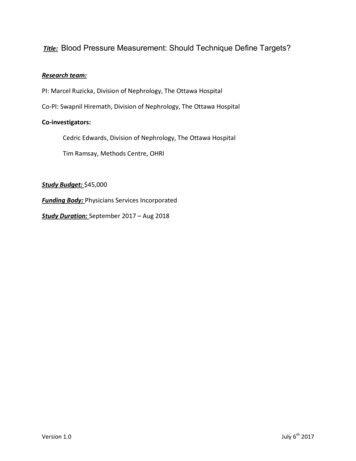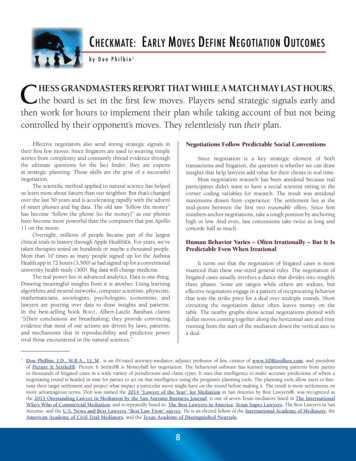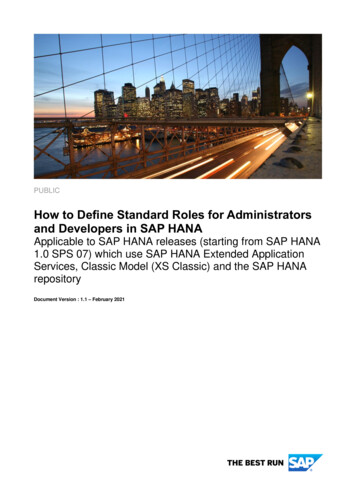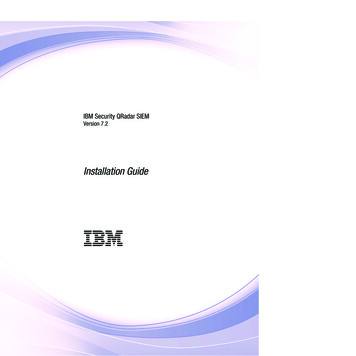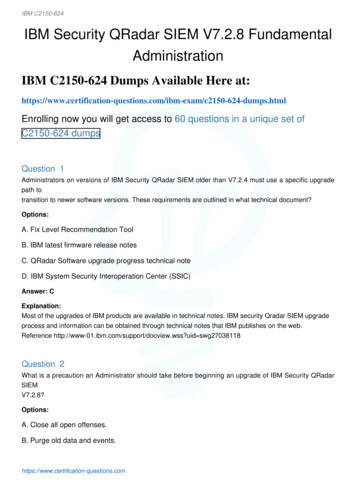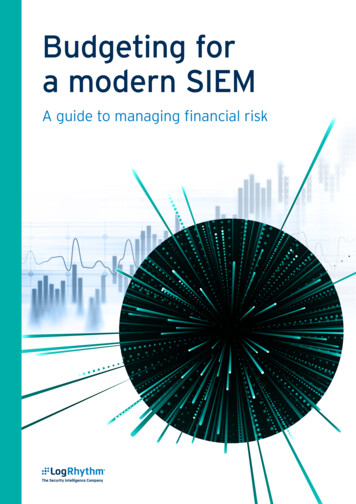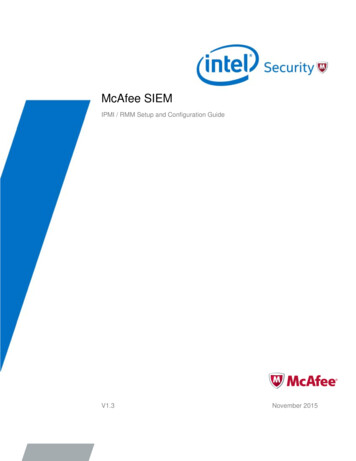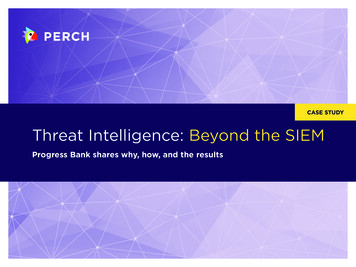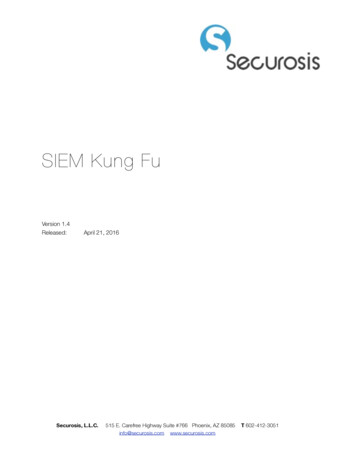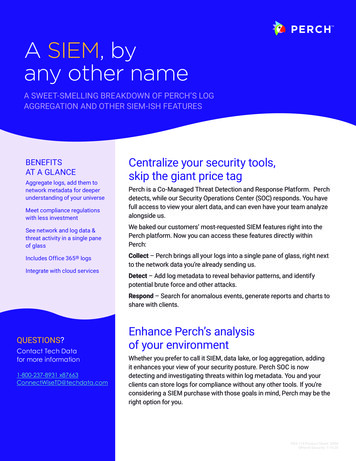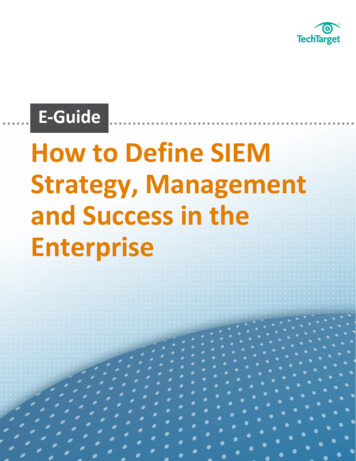
Transcription
How to Define SIEMStrategy, Managementand Success in theEnterprise
ContentsSIEM technologyprimer: SIEMplatforms haveimproved significantlyUnlocking theopportunity of SIEMtechnologySecurity informationmanagement systemsaspire to real timesecurityFive tips to improve athreat andvulnerabilitymanagement programSecurity information and event management technologyhas traveled a long and winding road, but today enterpriseSIEM technology is as functional, manageable andaffordable as it's ever been. Yet many enterprises haven'timplemented a modern SIEM product, and others that havearen't taking full advantage of the advanced capabilities ofcontemporary products. In this Essential Guide, learn todevelop or refresh your enterprise SIEM strategy to set thestage for SIEM success today and tomorrow according tohow you best define SIEM for your business.SIEM technology primer: SIEM platforms have improved significantlySIEM technology primer: SIEM platforms have improvedsignificantlyJane Wright, Site EditorSecurity information and event management (SIEM) products grew out of twonarrower product categories in the past decade. Security informationmanagement (SIM) software and appliances were used to collect and reviewlogs of data from host systems, network devices, security devices andIs centralized loggingworth all the effort?applications. Security event management (SEM) products came next,providing automated reviews of log data in real time, looking for anomalies orevent correlations that signaled a security threat or a compliance violation.Gradually, SIM and SEM vendors merged these tools into SIEM technologyplatforms.SIEM platforms recently evolved further to collect data about users‘behaviors and data access. SIEM platforms may collect data from hundredsof sources, including hardware devices, virtual machines and applicationssuch as Microsoft Exchange and Oracle databases.Rocky start for SIEM technologyThe earliest SIEM deployments were often a disappointment, according toJessica Ireland, research analyst for Ontario-based Info-Tech ResearchPage 1 of 21
Group. Customers tried to implement all of the SIEM functions with allavailable sources, which added more complexity than most customers couldabsorb in a short time. As a result, most of the logs collected by the SIEM satContentsunviewed, and many customers would label their SIEM project as a failure.Over time, customers were encouraged to start their SIEM project with justSIEM technologyprimer: SIEMplatforms haveimproved significantlyUnlocking theopportunity of SIEMtechnologySecurity informationmanagement systemsaspire to real timesecurityFive tips to improve athreat andvulnerabilitymanagement programone objective (threat monitoring or compliance reporting, but not both) andjust a small set of sources (for example, just the network devices), to gainskills and experience and gradually grow their SIEM project at a manageablepace.Current SIEM technology offeringsSIEM platforms have improved significantly in the past few years. ―Theproducts keep getting better,‖ Ireland said. ―We‘re seeing a lot of fluid andintuitive interfaces, which make SIEM easier for clients to use.‖One example of the easier interface is the ―replay‖ function. This enables theadministrator to recreate a past incident or attack and develop a new policyfor times when a similar incident occurs in the future.Alerts and responses have also improved in most SIEM platforms, accordingIs centralized loggingworth all the effort?to James McCloskey, senior research analyst at Info-Tech Research Group.Early implementations of automated responses caused problems, such asactions being taken when the alert was actually a false positive. ―A lot of thekinks in automatic response systems have been worked out,‖ McCloskeysaid. ―More people are comfortable that their SIEM will properly correlate anattack with information from other tools, such as a Web content filteringproduct, and respond appropriately.‖Major SIEM technology vendorsThere are approximately two dozen vendors actively selling in the SIEMspace. In its 2011 Magic Quadrant for SIEM report, Gartner Inc. placedHP/ArcSight LLC, Q1 Labs (acquired by IBM), RSA (the security division ofEMC), Symantec Corp., LogLogic Inc., NitroSecurity Inc. (acquired byMcAfee) and Novell Inc., in the leaders quadrant. Vendors such as NetIQPage 2 of 21
Corp, eIQnetworks Inc. and others fill the remaining quadrants of Gartner‘sreport.ContentsThe majority of SIEM vendors are particularly active in North America, wheremost of the first SIEM platforms were sold. In recent years, interest in SIEMSIEM technologyprimer: SIEMplatforms haveimproved significantlyUnlocking theopportunity of SIEMtechnologySecurity informationmanagement systemsaspire to real timesecurityFive tips to improve athreat andvulnerabilitymanagement programtechnology has expanded to Europe, Latin America, Australia andAsia/Pacific regions.SIEM marketAccording to the Gartner report, the SIEM market is mature, with manycustomers having their SIEM implementations in place for more than a fewyears, and some shopping for an upgrade or replacement to their initial SIEMchoice.Large enterprises continue to be the predominant purchasers of SIEMplatform products, Ireland said. SMB customers are more likely to employ amanaged security services provider (MSS) for SIEM functions. Some SIEMvendors now offer scaled-down versions of their platforms, supporting asmall number of logs from a limited number of log sources, to provide a lowerprice point for SMB customers.Is centralized loggingworth all the effort?SIEM technology: Typical usesCustomers typically use SIEM products for two reasons: to spot evidence ofsecurity threats or security breaches, and to ensure their organization iscomplying with regulatory standards. A 2011 Forrester Research survey(sponsored by SenSage) showed most customers are currently using theirSIEM tool for both threat management and compliance reporting.While the decision to install a SIEM platform may be made by the ITdepartment, the compliance manager, or a business unit within anorganization, Gartner‘s report stated ownership and management of theSIEM platform usually goes to the IT team.Page 3 of 21
The future of SIEM technologyAll those logs of data captured by the SIEM are growing, especially as SIEMContentsplatforms begin to capture usage and incidents from mobile devices. For thisreason, some vendors are working to connect business intelligence andSIEM technologyprimer: SIEMplatforms haveimproved significantlyanalytics tools to SIEM data. In its 2011 report, How Proactive SecurityUnlocking theopportunity of SIEMtechnologyability to discover and respond to new threats.Security informationmanagement systemsaspire to real timesecuritySIEM platforms with GRC (governance, risk and compliance) products, orFive tips to improve athreat andvulnerabilitymanagement programOrganizations Use Advanced Data Practices to Make Decisions, Forrestersaid the IT industry is currently poised at the intersection of SIEM, datawarehousing and business intelligence, which could potentially unlock theIn addition, many of the larger SIEM vendors are working to integrate theirwith identity and access management products.Ireland believes some vendors will accomplish this three-pronged approachof SIEM, GRC and security infrastructure through acquisitions. ―We expectfurther consolidation as more vendors try to pull these three prongs of SIEM,GRC and security infrastructure together,‖ Ireland said. ―Some of the largervendors may grab up the few remaining niche players.‖Is centralized loggingworth all the effort?Unlocking the opportunity of SIEM technologyUnlocking the opportunity of SIEM technologyAndrew HutchisonEnsuring the ongoing integrity of an enterprise information technologyenvironment is a formidable task, and one that requires every advantage adelivery management team can harness. Security information and eventmanagement, or SIEM, can create a significant advantage in providingenterprises with a comprehensive, coordinated view of the security status oftheir environment. The challenge in security is always to remain one stepPage 4 of 21
ahead of those who may try to compromise the integrity in some way.Implemented properly, SIEM technology can be a powerful technique forobtaining advantage over individuals or technologies with malicious intent.ContentsThe opportunity of SIEM is to establish a centralized, coordinated view ofSIEM technologyprimer: SIEMplatforms haveimproved significantlysecurity-related information and events. The underlying principle is that suchUnlocking theopportunity of SIEMtechnologynetwork equipment -- and even specialized security equipment like firewalls,Security informationmanagement systemsaspire to real timesecurityIn this article, we examine how a SIEM system works and what types ofFive tips to improve athreat andvulnerabilitymanagement programIs centralized loggingworth all the effort?inputs are produced in multiple locations, but without seeing ―the big picture,‖it may not be obvious that trends or patterns are occurring. By establishing acollector network, the security-related events from end-user devices, servers,antivirus or intrusion prevention systems -- can be gathered and inspected.events can be integrated, including new data sources such as fraud detectionsystems and network access control technologies that haven‘t always beenin scope for a SIEM deployment. We also look at the process for detectingactual security threats or incidents and steps organizations can take todevelop a SIEM capability.SIEM componentsAs indicated, the opportunity of SIEM is that information from diverse sourcesand systems can be collected. Often the volumes are very high and the SIEMsystem needs to ensure it is capable of handling the events withoutbecoming overwhelmed. SIEM systems are typically constructed in ahierarchical manner so collection can be done at multiple levels. Some sortof agent is often deployed in multiple locations, communicating back to acentral SIEM management node at which detailed analysis takes place.In some systems, pre-processing may happen at edge collectors, with onlycertain events being passed through to a centralized management node. Inthis way, the volume of information being communicated and stored can bereduced. The danger, of course, is that relevant events may be filtered outtoo soon, so a balance is required and this is the challenge of SIEMdesigners and implementers. At the central node, analysis techniques areapplied to interrogate, aggregate and correlate the incoming information. ThePage 5 of 21
better the analysis techniques, the more value can be derived from the SIEMenvironment.ContentsFeeding the SIEMSIEM technologyprimer: SIEMplatforms haveimproved significantlyDepending on the level at which security-related information and events areUnlocking theopportunity of SIEMtechnology(successful or not, user information, administrator logins, Kerberos eventsSecurity informationmanagement systemsaspire to real timesecurityconnection attempts, blocked connections, IP address information, etc).Five tips to improve athreat andvulnerabilitymanagement programcollected, a SIEM can be quite versatile. Traditionally, it is the infrastructurerelated events that are collected by SIEM systems. The operating systemsrunning on end-user devices and servers can forward information like loginsetc.), antivirus system alerts (successful/unsuccessful updates, repairs,infection details, etc.), and communication subsystem information (portAdditional information from network devices such as routers, firewalls, andintrusion prevention systems can also be forwarded to a SIEM to provideinformation relating to these aspects of the infrastructure, too.To be able to identify anomalous events, it‘s important the SIEM can alsobuild a profile of the system under normal event conditions. For this reason,items such as successful system logins are also typically recorded toestablish a norm against which abnormal logins can be detected. Rich eventsIs centralized loggingworth all the effort?relating to access of the network can also be integrated in environmentswhere network access control (NAC) is enabled. It may be possible to pickup patterns of denied access, or to detect patterns of network access byvirtue of the NAC mechanisms of checking credentials, device addresses etc.to prevent unauthorized devices from connecting to an enterprise LAN.Sometimes it is also useful to have knowledge of other system information,such as processor or memory utilization to determine whether there is anunexpected change in the status of a system. For this reason, it is useful tohave other contextual information available for the SIEM management team.While we are suggesting that SIEM has a special focus and separateness,it‘s often this kind of system information that exhibits the effect of an incident.So SIEM should also be viewed as part of an overall, comprehensivesystems management approach.Page 6 of 21
When talking about the business impact of security incidents and where thereal damage occurs, corporations often say the transactional level is themost dangerous. Fraudulent transactions can result in direct costs forContentsorganizations, and this can come at a very high price. An opportunity forSIEM systems is to collect information that is above the infrastructure levelSIEM technologyprimer: SIEMplatforms haveimproved significantlyand which derives from application and business systems. Being able toUnlocking theopportunity of SIEMtechnologygenerated events is they tend to be non-standard, whereas a wholeSecurity informationmanagement systemsaspire to real timesecurityintegrate and interpret, this is effort well spent in terms of taking the SIEMFive tips to improve athreat andvulnerabilitymanagement programintercept a transaction where an approver is the same person as therequestor, or where other separation-of-duty requirements are compromised,could be of high relevance to an organization. The difficulty with applicationpopulation of operating system devices generate events of similar format andsemantics [meaning]. Although application events may require some work tofrom the engine room to a system that also incorporates business processinformation.As a final word on the type of events a SIEM should aim to incorporate, it‘salso necessary to interpret system or application events in the context ofexternal events. Unusual behavior patterns may be detected by security staff,based on SIEM alerts, but these could relate to system modifications inchange control windows (with, for example, more privileged logins thanIs centralized loggingworth all the effort?usual), the time of day or seasonal variations such as increased tradingvolumes from a Black Friday or pre-Christmas rush.Detecting threats with SEIM systemsFrom the multitude of security information presented, SIEM systems have tomake sense of the feeds received and determine whether alarms need to beraised, operators need to intervene or if warnings should be provided. Thetask is a bit like finding a needle in a haystack. Overall though, the accuracyaspect of a SIEM should be to reduce false positives, whereby patterns thatdon‘t relate to an attack or malicious behavior are reported as such.At the most basic level, static rules can be configured in SIEM systems and,based on logical expression evaluations, these will either be activated or not.A similar approach is to configure thresholds, whereby identification ofPage 7 of 21
certain numbers of events (or some combination of event types) will result ina flagging of this occurrence.ContentsMuch of the focus of future SIEM work is on moving from static detectiontechniques to dynamic ones that are capable of identifying behaviors notSIEM technologyprimer: SIEMplatforms haveimproved significantlyseen before. The latter type of system uses techniques such as anomalyUnlocking theopportunity of SIEMtechnologyfrom a norm. Experimental systems based on such techniques are showingSecurity informationmanagement systemsaspire to real timesecurityFive tips to improve athreat andvulnerabilitymanagement programdetection based on artificial intelligence. Through employing techniques offinding anomalous points or anomalous series, depending on the types ofdata, statistical or time series analysis can be performed to find deviationspromise, and such learning type systems will increasingly be incorporated incommercial systems too.In addition to techniques that can detect anomalies and outliers, securityvendors, managed service providers, researchers, and universities areworking to enhance prediction of attack situations. Through various attackmodeling techniques, systems can compare incoming events with certainpatterns and determine whether an attack pattern is being observed. This isparticularly powerful, specifically for dealing with zero-day type attacks.Responses to incidents can be characterized as reactive or proactive, butidentifying attacks in advance can be challenging. Where attack patternsIs centralized loggingworth all the effort?have been seen before these can be incorporated into rule-bases orcorrelation engines. In this way, rules can be changed to add or adapt astatic/threshold response. Post-event analysis can help to prevent futureoccurrences.As a final word on detection, it is important to recognize that the SIEMsystem needs to form part of an overall security process. It is arguably just asimportant to have appropriate interfaces, channels, alerts and inspectioncapabilities available to SIEM operators, as it is to have the relevant securitysource information and events collected by the SIEM.Developing a SIEM capabilityIn terms of establishing a SIEM capability, an organization may either do thisdirectly through its IT function or retain a service provider to perform thisPage 8 of 21
service along with other systems or security services. Various products areavailable from major vendors and there also are open source options such asAlien Vault.ContentsA project to establish SIEM functionality requires the incorporation of manySIEM technologyprimer: SIEMplatforms haveimproved significantlyheterogeneous devices. In some cases, SNMP information feeds may exist,Unlocking theopportunity of SIEMtechnologydedicated, external team. In one large SIEM deployment studied, there wereSecurity informationmanagement systemsaspire to real timesecurityFive tips to improve athreat andvulnerabilitymanagement programin other cases syslog information is derived and fed to the analysis engine.Overall, though, a careful mapping of events, incorporating all operatingsystems and devices needs to take place. This should be done with asignificant delays because the same team running day-to-day security alsotried to build the SIEM capability.When collecting and scrutinizing events via a SIEM deployment, otherproblems in the IT environment may surface. For example, inconsistentconfiguration can lead to one device generating huge volumes of eventinformation, in contrast to other devices emitting very little (or no) information.This can lead to an anomaly based system flagging this differenceimmediately. To counter this, servers and domain controllers can beconfigured for how ―verbose‖ they are with their logging information. Theestablishment of a SIEM environment has the additional benefit of creating aIs centralized loggingworth all the effort?real bottom-up view of an environment, and for giving security operationcenter teams a feel for the norms that should be seen. Documentation andmapping of security events are other useful by-products of a SIEMdeployment.Looking ahead: Future of SIEMThe future of SIEM systems is promising, especially with additional detectiontechniques being developed and incorporated into SIEM analysis engines.The evolution to an ―Internet of things‖ means many more devices will be IPenabled, and
collector network, the security-related events from end-user devices, servers, network equipment -- and even specialized security equipment like firewalls, antivirus or intrusion prevention systems -- can be gathered and inspected. In this article, we examine h
